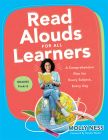
Small Groups for Big Readers
Ten Questions Answered About Core Reading Instruction in the K–5 Classroom
This book promotes small-group reading as a key tool for K–5 teachers, offering frameworks, videos, and text strategies. Teachers can differentiate instruction with evidence-based routines, creating a dynamic learning environment that nurtures readers and aligns whole-class instruction with small-group lessons.
Implement small-group reading instruction
In Small Groups for Big Readers, the authors advocate for small-group reading instruction as an effective way for teachers to help all students grow as skilled, developing readers. Through small-group instruction, K–5 teachers can differentiate instruction by using evidence-based routines, adopting an asset-based lens, and selecting texts tailored to students’ unique interests, needs, and goals, creating deeper engagement in reading.
K–5 teachers can use this book to:
- Understand and apply evidence-based routines that promote equitable, accessible literacy instruction
- Enhance students’ reading and knowledge building through carefully planned interactions and opportunities with text
- Empower students by establishing clear goals and guidelines for small-group lessons
- Plan for extended learning opportunities that provide sufficient, deliberate practice for literacy development
- Extend professional expertise by selecting and adapting strategies to differentiate literacy instruction, using a flexible, choose-your-own-adventure format to customize learning based on individual goals and needs
Related Topics
Additional Information
"This book is a phenomenal resource as the author team expertly sets the stage for why literacy matters and centers Students as Readers. Throughout the book, the action guide plan outlines detailed strategies to facilitate whole-group, small-group, and individual approaches to monitor and respond to develop students' progress in reading—gradually and intentionally. Early career teachers as well as experienced educators and leaders can all benefit from the perspectives provided through this book’s series of guiding approaches and vignettes in the classroom videos regarding building Students as Readers."
"Small Groups for Big Readers is a groundbreaking book that highlights the transformative power of small-group reading instruction. With a practical, question-driven structure, this book offers educators the tools and strategies to deliver impactful, student-centered instruction that truly supports every reader. A must-read for anyone committed to fostering literacy and meaningful learning in their classrooms!"
"Small Groups for Big Readers is an essential book for educators looking to harness the power of small group reading instruction. Grounded in practical strategies and framed by the real questions teachers face, this book provides a clear road map to delivering impactful, tailored instruction that meets the diverse needs of students. It’s an invaluable resource for building confident, capable readers."



